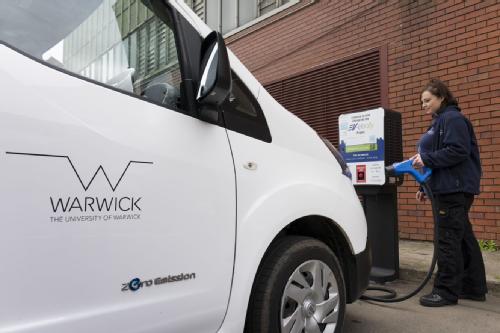During the course of this year, the University of Warwick’s EV-elocity project has been deploying V2G chargers in a range of locations across England to as part of large-scale trials to gain technical, customer and commercial insights on emerging V2G (vehicle-to-grid) technology.
With vehicle-to-grid (V2G) technology, EV batteries could store electricity – when there is an abundant supply – to power homes and businesses and discharge it back to the national grid when it is most needed.
This enables better use of renewable energy, lower carbon footprint, less pressure on the grid and financial savings, which can help electric vehicle owners pay back their investment.
The University is also investigating if, and how, additional use from V2G charging may affect EV battery life.
The project, led by Cenex, a not-for-profit consultancy specialising in delivery of low carbon vehicles and energy infrastructure projects also involves the Universities of Nottingham and Warwick; Leeds and Nottingham City Councils; and CrowdCharge, a platform that integrates and optimises smart electric vehicle charges.
EV-elocity is funded by the Department for Business Energy and Industrial Strategy (BEIS) and the Office for Zero Emission Vehicles (OZEV), in partnership with Innovate UK, part of UK Research and Innovation.
Chris Rimmer, Infrastructure Strategy Lead at Cenex, said: “After restarting the project in mid-2020, we are delighted to be testing V2G with such a range of sites and hardware. We’ll be working hard over the coming months to examine the cost, carbon and conditioning benefits of V2G, and publish our results as they become available.”
Professor James Marco, from WMG at the University of Warwick, said: “A number of consumers and vehicle manufacturers are concerned that V2G will disproportionately reduce battery life, representing a potential barrier for widespread adoption of V2G and consumer acceptance. Here at WMG, University of Warwick, we are excited to be researching novel new methods of managing the V2G charging process not just to mitigate battery degradation, but to potentially use V2G to extend battery life.”
With V2G technology, EVs could help to support grid resilience when parked and plugged-in. Instead of installing huge and expensive community battery stores, an extensive network of EV batteries could be harnessed to absorb energy when renewable generation is plentiful and export it back to the grid during peak demand when carbon intensity is highest for a profit, making money back for users in the process.
The project is installing multiple V2G charging demonstrators at sites owned by organisations -including city councils, universities and police forces – that employ large electric vehicle fleets. Latest data suggests that if the 5.3 million fleet vehicles on UK roads today were to switch to EV, it would save as much as 25% of all UK transport emissions.
Dr Julie Waldron, Research Fellow at the University of Nottingham, who is studying user behaviour, said: “Company cars and vans tend to earn money while out on the road, but electric vehicles could also be a source of income when they’re parked up. We know cost is a major factor deterring mass adoption of electric vehicles, but if V2G charging helps EV owners get a quick return on their investment, it could make purchasing electric vehicles a much more attractive option to a bigger customer base.
“Understanding the patterns of vehicle usage will allow us to evaluate the best charging infrastructure required for EVs, for example the locations and type of charging points and plugs (which currently vary between car brands), compatibility with V2G, charging periods and energy demand, etc. This will enable us to rethink the system and inform the users’ decision-making process in order to maximise benefits for consumers and the planet.”
Using data from V2G chargers and trackers in EV cars, and user behaviour analysis on the study, researchers are examining mobility patterns, EV charging requirements/trends, battery degradation, and electricity generation, storage and use.
With the biggest electric fleet of any local authority in England, Leeds City Council has installed 5 V2G chargers under the EV-elocity project. The University of Nottingham, another user of EV fleets, has installed two V2G units on its main campus.
Cenex installed one V2G charger at Loughborough University Science and Enterprise Park, one charger at Worcestershire County Council and two chargers at West Midlands Police. University of Warwick installed three chargers on campus to be used by the Estates fleet.
Nottingham City Council, which also has a large electric vehicle fleet and a very ambitious target to become carbon neutral by 2028, is planning to install 40 units.
Image: courtesy University of Warwick








